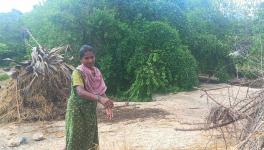Report Finds Environment, Human Rights Violations by BALCO in Daldali, Chhattisgarh

Image Courtesy: Twitter
What are the environmental and human costs of bauxite ore mining when an undertaking with 49% government stake bends all rules of environmental clearances and launches a huge mining expedition? The answer lies in a report recently released by the Centre for Policy Research-Namati Environmental Justice Programme, along with three other organisations -- Oxfam India, Janabahivyakti, and Vanvasi Kisan Mazdoor Vikas Samiti (Bodai-Daldali), which throws up some answers and asks a host of probing questions.
The report, ‘Closing the Enforcement Gap: Groundtruthing of Environmental Violations in Bodai-Daldali Chhattisgarh’ has done so by following a process of “groundtruthing”-- visiting the sites at regular intervals for investigations -- what they call “scoping visits”, meetings with locals, analysis of social justice issues, and collection of all relevant information from government websites and numerous RTI applications. This exercise has revealed a staggering number of violations of environmental norms and laws related to human rights and protection.
The facts stated in the official documents were compared with the impacts being reported by the affected villagers and the civil society organisation working in the area. Based on this discussion, the following issues were decided to be taken up by the research group to study through the groundtruthing methodology.
- Dust pollution as a result of transportation, blasting and drilling
- Mined out pits in which backfilling has not been done, which runs the risk of children and cattle falling in
- Reported health risks and threats to the life of labourers
- Incomplete rehabilitation and resettlement process
- Fall in the groundwater level in the area
The Project
The first Environmental Clearance (EC) granted to the Bodai-Daldali bauxite mine in 2003 was for a capacity of 0.30 million tonnes per annum (MTPA) for bauxite mining. In 2006, a proposal was put forth by Bharat Aluminium Company Ltd. (BALCO), a public sector company whose 51% stake was acquired by private sector Vedanta Resources in 2001, company to increase the production capacity to 1.25 MTPA. While examining the proposal, the Expert Appraisal Committee (EAC) had observed that the project had not been complying with several conditions specified in its EC from 2003.
In October 2007, the EAC on mining projects categorically rejected the proposal for expansion. The poor performance of BALCO in conserving the rich biodiversity of the area, and in the rehabilitation of the affected and to be affected population prompted the EAC to come to the conclusion that the proposal was being put forth with a purely commercial interest in mind and that the acceptance of such a proposal would lead to unavoidable human suffering.
The irregularities expanded to the actual ore extraction as well. In 2006-2007 and 2007-2008, BALCO exceeded the production capacity specified in the EC and subsequently a court case was also filed against it in the Chief Judicial Magistrate’s Court in the district of Kabirdham.
Thereafter, in November 2008, BALCO introduced two new elements to persuade the EAC to grant them approval. Neither of them was related to environment or social aspects of the project. The first was the growing competitiveness of the global market and the second was the importance of the mine being approved in national interest.
Three laws have been used in this groundtruthing -- The Environmental Impact Assessment (EIA) Notification, 2006, the Air (Prevention and control of Pollution) Act, 1981 (Air Act) and the Water (Prevention and control of Pollution) Act, 1974 (Water Act).
Findings of the Report
Efforts were made to maximise the participation of people affected by the mining operations in the area. However, some of these processes were hindered due to inaccessibility and political instability in the region. The non-compliance of environmental safeguards was further corroborated with government reports and studies by other organisations. It was found that dust is generated due to uncovered trucks plying on poorly maintained roads, mining activities such as drilling and blasting, and despite that, the air quality monitoring was not being carried out by the project proponent. There was also no record of reclamation or evidence of plantation. The people still living within the mine lease area suggested that the Resettlement and Rehabilitation( R&R) process is yet to be completed.
Alongside the environmental violations, the mine operated beyond its permitted capacity in 2006-07 and 2007-08, the report says. In 2017, after the Ministry of Environment and Forests (MoEF), allowed projects to get post-facto environmental clearances, this project applied for approval, and an appraisal for a modernisation proposal is under way in the MoEF.
Dust Pollution
Dust pollution was an important concern that was raised during the village level meeting. It was identified that the drilling and blasting process for the extraction of the ore and its transportation was generating a lot of dust. Some of the major issues were:
•Blasting is carried out in pits located very close to the habitations. People said small boulders often fly out and land either near or on houses.
• Drilling results in a spiral of dust being generated and since there is no mitigation measure in place, the dust enters homes and a red layer was seen in several places.
• The road used to transport the ore within the mining lease premise is not black topped and hence susceptible to large amounts of dust getting deposited. As vehicles move along this road, clouds of red dust are created.
•The 42-km-long road from Bodla to Daldali is used for transporting minerals as also by people to reach nearby towns. With open trucks transporting tons of bauxite on the very same road, the road has been riddled with potholes. People that during summer and winter, a layer of red dust covers the, the monsoon sees the dust mix with the water and fill up the potholes with mud. Resultantly, local transportation becomes quite difficult.
Backfilling of Mined Out Pits
Prabhu, a resident from Mundadar, one of the four core villages, wants back the piece of land he lost as a result of the mine operation. According to him, the members from the Vanvasi Kisan Mazdoor Vikas Samiti have discussed with the state authorities that all land that has been mined out should be reclaimed. There exists nothing on official records, however, as to how or in what condition the land will be returned.
Linked to this, the following problems were discussed during the meeting that took place in August 2018:
•The void pits are not backfilled properly and it is unsafe for both children and cattle who live near around the area.
• Although the overburden had been used to fill up some pits, the land has not been levelled and the top soil has not been used to cover the soil to prepare the land for plantation/agriculture.
The six-monthly compliance report, dated 23.11.2018, for April 2018-September 2018, specifies that the overburden soil is being concurrently backfilled, but photographs, Google Earth images collected by the research team in 2018 of the mine lease area show barren lands with upper laterite, no top soil and no plantation. The images also show the abandoned void pits and some backfilled pits with no top soil reclamation. However, this has not been noted in any official documents, which is perhaps why the problem persists.
Health Hazards and Threat to Labourers
The mining operations have affected the livelihood of the villagers. In order to secure alternate livelihood, the villagers, both tribal and non-tribal, were engaged as labour in the mining operations. It was discussed during the second meeting in August 2018 that those who were working in the mine be provided with few safety gears such as helmets, gloves and shoes. However, there was very little awareness among labourers regarding what was to be done with the protective gear. Consequently, none of the gear was being used.
It was reported that workers use their bare hands to first hammer the ore into small parts and then load the mineral on trucks. Despite them not using even the most basic safety gears, they were allowed to work without any protective measures. This had also been documented in a video put together by Mines and Communities in 2016 in which the actual working conditions in the mine were juxtaposed to a video prepared by BALCO that showcased the state of the labourers working in the mine.
Among the other issues flagged by the report, the one of R & R is significant.
The point of contention, that almost restricted BALCO’s expansion from 0.30 MTPA to 1.25 MTPA, was the R&R of the families living within the lease area. Thereafter, the expansion was allowed with assurance by BALCO to ensure that the remaining families would be paid compensation and thereafter resettled. This is even linked to Specific Condition (i) of the EC granted on 09.04.2010, which clearly states:
“The Company shall pay compensation for acquisition of private land and rehabilitation of displaced families at rates not less than those prescribed in the applicable Central Government/State Government norms. The Resettlement of all the affected families should be completed as per their commitment, i.e.early 2010.”
The 2011 census of Kabirdham district identifies 143 families still living in the villages of Mundadar, Keshmarda, Rabda and Semsatta. Although the exact number of people living within the mining lease area is not known, many have chosen to remain since the process of R&R and the compensation offered has been quite below what they expected to receive, the report said.
For the ones who have been paid compensation, it has been done at a paltry rate of Rs. 1 lakh per acre and 405 square meters for building a house for those with land titles and a token Rs. 4,000 for those without land titles. Some even reportedly got cheated due to them by various middlemen.
One of reasons for the categorical rejection of a proposal for expansion in 2007 was the fact that the EAC opined that BALCO, on account of being a private company, should have followed a comprehensive and well-designed R&R policy for the affected people.
The report goes on to ask -- what is being done about these blatant violations? Is no one, not least the government, willing to listen, sit up and take notice?
Saurav is an independent journalist based out of Delhi, and specialises in reporting on legal, human rights and gender issues.
Get the latest reports & analysis with people's perspective on Protests, movements & deep analytical videos, discussions of the current affairs in your Telegram app. Subscribe to NewsClick's Telegram channel & get Real-Time updates on stories, as they get published on our website.
























